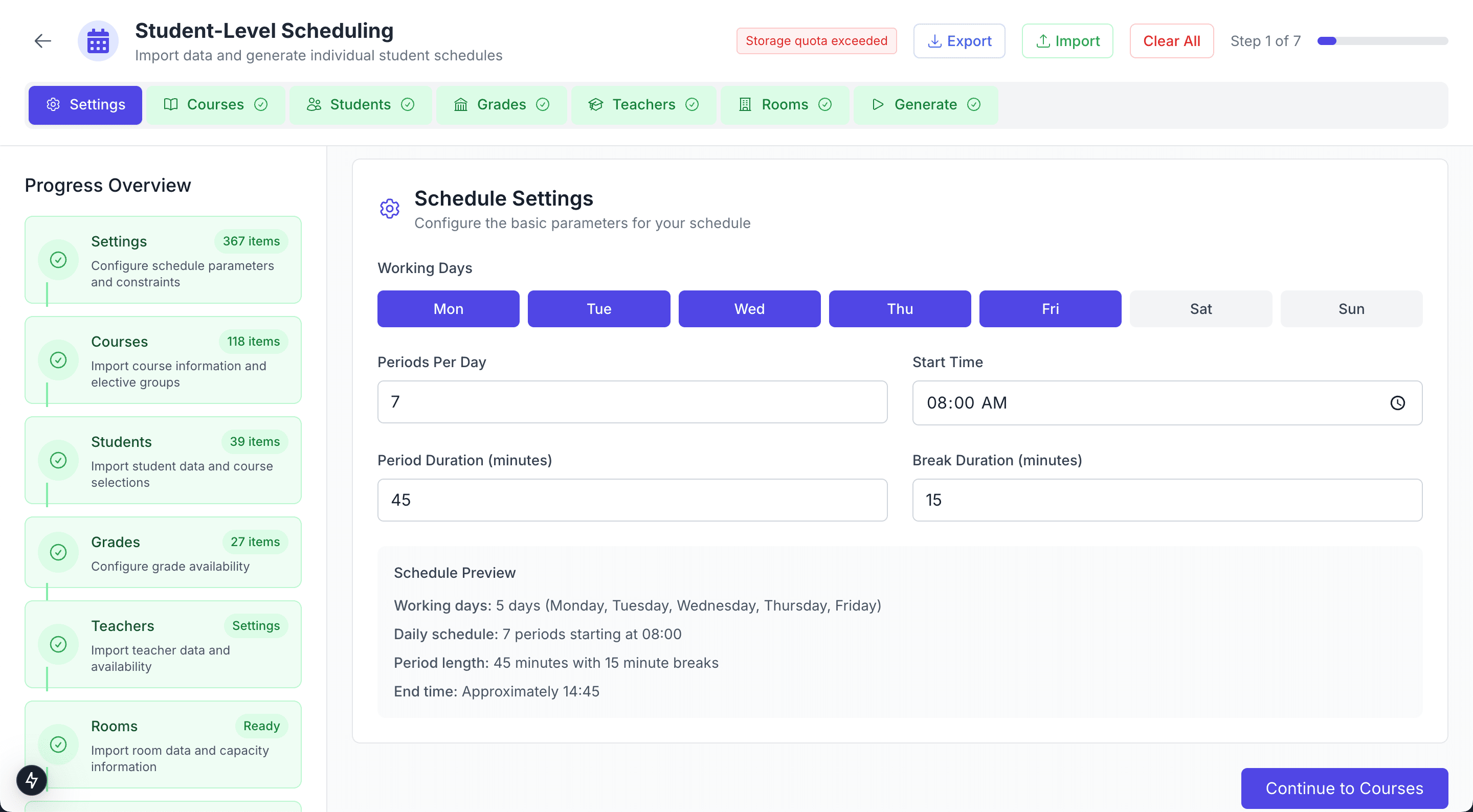Step 1: General Settings
General Settings form the foundation of your Individual Student Schedule Generator. These parameters define the basic structure of your academic schedule and apply to all courses, students, and teachers in your system.
Configuring Your Academic Schedule

General Settings interface showing schedule parameters
Working Days
Purpose: Define which days of the week classes will be scheduled.
Configuration:
- Select from Monday through Sunday based on your institution's operating schedule
- Most schools use Monday-Friday, while some programs may include Saturday
- Exclude days when no classes are held (such as weekends or designated non-academic days)
Example: A typical college might select Monday, Tuesday, Wednesday, Thursday, and Friday for a 5-day academic week.
Periods Per Day
Purpose: Set the number of class periods available each day.
Considerations:
- Include regular class periods but exclude lunch and major break times
- Consider your institution's period duration and total academic hours
- Account for any assembly periods or non-academic time blocks
Example: An 8-period day might run from 8:00 AM to 3:30 PM with appropriate breaks included.
Planning Tip: When setting periods per day, consider that students will need time to move between different rooms and buildings. The system accounts for this in scheduling, but having realistic period counts helps create practical timetables.
Start Time and Period Duration
Start Time: The beginning of your first period each day.
Period Duration: Length of each class period in minutes.
These settings work together to create your daily schedule framework. The system automatically calculates break times and transitions between periods.
Common Configurations:
- 45-minute periods with 5-10 minute transitions
- 50-minute periods for semester-based systems
- 60-minute periods for block scheduling
- 90-minute periods for college-level courses
Break Duration
Purpose: Time allocated between periods for students and teachers to transition between rooms.
Recommendations:
- 5 minutes: For small campuses with nearby rooms
- 10 minutes: Standard for most schools and colleges
- 15 minutes: Larger campuses or when significant room changes are expected
Validation and Next Steps
Before proceeding to the next step, make sure your settings are correct:
Check Your Settings:
- Working days match your institution's schedule
- Period count allows adequate time for all courses
- Start time and duration create realistic daily schedules
- Break duration accommodates campus layout and transitions
Common Settings Examples
High School Example
- Working Days: Monday - Friday
- Periods Per Day: 7
- Start Time: 8:00 AM
- Period Duration: 45 minutes
- Break Duration: 10 minutes
College Example
- Working Days: Monday - Friday
- Periods Per Day: 6
- Start Time: 9:00 AM
- Period Duration: 50 minutes
- Break Duration: 10 minutes
University Example
- Working Days: Monday - Saturday
- Periods Per Day: 8
- Start Time: 8:30 AM
- Period Duration: 60 minutes
- Break Duration: 15 minutes
Next Steps
Once your General Settings are configured and you're satisfied with them, you're ready to move to Course Configuration where you'll define your institution's course catalog and requirements.
Quick Checklist:
- Working days selected match your institution's schedule
- Period count allows adequate time for all courses
- Start time and duration create realistic daily schedules
- Break duration accommodates campus layout and transitions
- All settings have been reviewed and confirmed